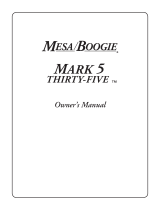
NOTE FROM THE AUTHOR: Douglas West A.K.A Tone Boy
Randy wanted me to give this bit of info to you personally, even though it felt a bit funny to write “I” as opposed to “we”, so that my
personal experience could validate the source.
From 1982-1991 I was the person who tested every finished amplifier here at MESA - along with my other duties in R&D, Customer
Service and writing Owner’s Manuals. I worked side by side with Randy (playing guitar and asking for more Tone and features) on
the revision of the MARK II B that would eventually become the MARK II C+… as well as every amp since. During that time is when
I was affectionately given the nickname Tone Boy for my relentless pursuit of a certain attack/morphing-harmonic characteristic I was
hearing in my head. I was driving Randy crazy then - and I must take the time here and now to give him my deepest thanks and
utmost respect for listening to my ranting and raving. He didn’t even play guitar - but he heard me - and had the belief in this quality I
described just as deeply as I did. And even better - he found a way to deliver it! From myself, and all of us guitarists who have made
this sound our own…Thank You!
Anyway, as to how this affects you as a MARK V owner, there is some inside info you need to know to get the most out of Channel
3. This especially applies to you MARK II C+ and MARK IV owners who will be looking for your old amps sound in this Channel and
probably even be comparing the MARK V side by side to your II C+ or IV.
Back when I was testing II C+’s every day in the burn-in room, I always thought the non-graphic amps had a certain attack and purity
to the sound that the amps that had Graphic EQ on them just didn’t have. There was an urgency and bold punch to the sound…they
seemed tighter and more cohesive. Now granted, we made far more amps with the on-board EQ than without…probably 70% had the
EQ, but not many people had the opportunity to compare day-in and day-out as I did. The EQ model had the shaping advantage…
no doubt about it, and certainly all the sounds that II C+ are famous for were created with the EQ being an integral part of that sound,
but when it came to the straight sound – no EQ – the non-graph model always got to me with it’s speed and authority.
So it was that I came to be the obsessive/compulsive owner of no less than 8 of the II C+ Simul-Class
™
, Reverb (non-graphic) heads.
I hand picked these as being the best sounding amps - for me - out of the thousands of II C+ we made. Out of these eight amps I
immediately found my favorite - which I dubbed “His Highness the C-ness” and which I used as a reference model to have our Chief
Tech and Archival Guru Michael Bendinelli, copy exactly on the other 7 amps. Everything was measured and scrutinized (pot values,
resistors, caps, transformers swapped, etc.) and duplicated, and in the end… all 8 sounded alike. Regardless, His Highness was my
golden reference for MARK II C+ Tone and our R&D reference amp for many MARK Series amps to follow, including the MARK IV.
Over the next two decades I found the need to part with some of these magic amps for studio gear and such and always I gave my
close friends first crack at these – but His Highness remains to this day a mysterious, sweet-singing, fire-breathing beast of an amp.
So naturally when it came time to do the Channel 3 sounds of the MARK V, we went to the Oracle – His Highness The C-ness - and
asked permission to pay our respects to His Golden Tone…He granted, and the work began.
In our endless comparisons of many original II C+’s - both EQ and non-EQ samples - alongside this golden reference, we discovered
that I wasn’t just Tone-dreaming. There was actually a difference between the EQ model and those non-EQ models. It all came
down to a coupling capacitor at the end of the EQ circuit that feeds the driver. In the EQ model, it was a great big cap that let a lot
of sub-low pass, slowing down the sound and making it fatter. In my amp - a non-EQ version - this cap was smaller and didn’t let as
much sub-low through - which speeds up the sound and makes everything tighter and more urgent. There it was, a simple part…but
it made all the difference in the time domain.
Yet there were so many more of these slower, fatter sounding EQ versions out in the world… that many more people were used to
tHe CHannelS: (Continued)
PAGE 14





















